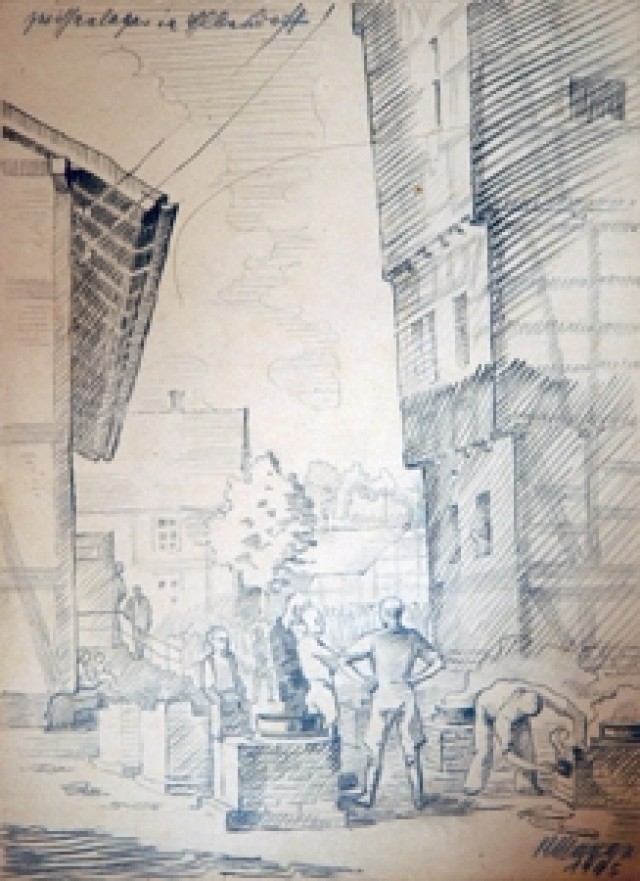HOHENFELS, Germany (April 28, 2008) -- We will never meet him and cannot communicate with him, but a stone etching of a bison on a cave wall can give us some insight into how the long-gone prehistoric artist saw his world.
Even far more contemporary eras such the World War II are fading further into history, making links to those times increasingly valuable. German artist Rudolf Menge was an prisoner of war in that era, and he spent his time interned sketching the people and scenes around him. Menge's nephew Helmut Schoen wanted to fulfill his uncle's wishes and preserve a bit of that era by donating those sketches to the U.S. Army.
"Margarete (Menge's wife and Helmut's aunt) always said he had a lot of respect for the American personnel in the POW camp, and therefore I would like to give them to veterans of the U.S. Army," Schoen said.
The collection contains more than 30 pencil sketches showing life in the POW camp in Ludwigsburg, near Stuttgart, Germany. At least half are portraits of his fellow prisoners. Others depict scenes of life in the barracks and around the camp. Some include dates and names; all are historically significant.
"Mr. Schoen wanted U.S. Soldiers and veterans to be able to see these, so he thought it was best to give them to the history people," said Gabriele Torony, staff curator for the U.S. Army Europe Office of Military History. "The best place to display them would be in a military history museum, but since we don't have one in USAREUR right now, they will be displayed as soon as we can find an appropriate place."
Born in 1908 in Naunhof, Germany, Menge studied at the Academy for Graphic Art in Leipzig, completing his art degree in 1929. By the time he was drafted into the German army, where he achieved the rank of sergeant, he was working as a freelance graphic artist.
Schoen says it was during his time in the camp that Menge really began to paint and sketch. Schoen and Menge met only once, around 1943 or 1944, though Menge says he corresponded frequently with Schoen's family. Menge and Schoen's father were good friends.
Through correspondence with his uncle, "it was obvious I was talking to an intelligent, technically interested man," Schoen said.
After the war Menge married Margarete, Schoen's aunt. His career expanded to include a teaching assignment at the technical school for painting at Mosbach. He was the head of the art union of Rappenau, a member of the Academia Italia delle Arti e del Lavoro, and received an appointment at Accademico d'Italia with gold medal. His work has been exhibited at Chateau Thierry, Flehingen, Bretten and Bad Rappenau.
Menge died in 1976, and Margarete eventually moved into a retirement home. She gave the majority of her husband's works to Schoen, who now has more than 250 of his uncle's paintings and sketches at his home in Pfaffenhofen, Germany. Large, vibrant pieces pack the walls in every room, portraying everything from landscapes to abstract works to allegorical scenes from ancient mythology.
In September Schoen suffered a stroke, spending five weeks in the hospital for treatment and rehabilitation.
"At this point I realized how fast my life could come to an end, and I don't want to have too much unfinished business. Part of that was to take care of the work of my uncle," Schoen said.
He approached museums and galleries, stressing that his goal was to make Menge's work available to the public. Financial gain was not important, he said. During this time he found additional pieces he had not seen before, including the POW camp sketches. He said he then decided to give them to the U.S. military, but since he could not transport them to the Unites States himself, he began looking for a point of contact in Germany.
Through the U.S. consulate in Munich, he contacted the U.S. Forces Liaison Office there and was directed to Torony in Heidelberg.
Schoen had framed a number of the sketches himself, though most were loose when he officially handed them over to the curator April 16. Torony said all the pieces will be preserved and eventually displayed so future generations of Soldiers and veterans can view them as the artist intended. Three sketches will be placed in U.S. Army Garrison Hohenfels headquarters.


Social Sharing